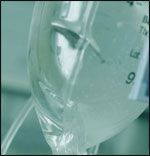Publication
Article
Pharmacy Times
coagulation counseling
Author(s):
Dr. Garrett is manager of the Health Education Center, Mission Hospitals, Asheville, North Carolina.
FDA APPROVES UPDATE TO LABEL ON BIRTH CONTROL PATCH

The FDAhas approvednew changesto the OrthoEvra ContraceptiveTransdermalPatchlabel to include the results of a newepidemiology study that found thatusers of the birth control patch wereat higher risk of developing venousthromboembolism (VTE) than womenusing birth control pills.
The FDA initially revised the labelfor Ortho Evra, which is applied oncea week, in September 2006 to warnwomen of the risk of VTE based on 2epidemiology studies. One study,conducted by i3 Ingenix, showedthat some women using the patchwere at a twofold greater risk of developingVTE. The other study, conductedby the Boston CollaborativeDrug Surveillance Program, showedthat women using the patch werenot at increased risk, compared withwomen using birth control pills containing30 to 35 mcg of estrogen andthe progestin norgestimate.
Transdermal delivery of estrogenexposes women to about 60% moreestrogen than typical birth controlpills. Increased levels of estrogenmay increase the risk of side effects,including VTE. Women should discussthe possible increased risk ofVTE with Ortho Evra with their healthcare provider and balance this riskagainst the increased chance ofpregnancy if they do not take a dailybirth control pill. Women with a highrisk of VTE (such as those over age40, those who smoke, etc) may wishto consider other methods of birthcontrol.
CONTINUOUS ENTERAL NUTRITION CAUSES WARFARIN RESISTANCE
A small retrospective crossover study of patients requiring continuous enteral nutritionin the intensive care unit of an academic medical center showed international normalizedratio (INR) changes when warfarin was coadministered with the enteral feedings.The study included 6 adults who required nutritional support for at least the first10 consecutive days of warfarin therapy. During the 10-day period, enteral feedingswere withheld for 1 hour before and after warfarin administration. The patients thencrossed over to a 3-day period where feedings were not withheld around warfarinadministration.
The change in INR during the period when feedings were withheld was significantly differentversus the change in INR during coadministration of warfarin with continuous feeding(-0.13). The authors concluded that continuous enteral nutrition should be withheldfor 1 hour before and after warfarin administration to prevent enteral nutrition?associatedwarfarin resistance. Further study is warranted to explain the warfarin resistance.
MEDICARE EXPANDS COVERAGE OF HOME INR MONITORING
The Centers for Medicare & Medicaid Services recently approved expanded coveragefor home international normalized ratio (INR) testing. New indications forhome testing include chronic atrial fibrillation and deep vein thrombosis. Previously,coverage was available only for patients with artificial heart valves. To qualify forhome testing, patients will need to be anticoagulated for at least 3 months prior touse of the home testing device, undergo face-to-face education regarding anticoagulationmanagement, demonstrate use of the device, continue to use the device correctly,and undergo testing no more than once a week.
Studies indicate that warfarin is underused for a significant portion of patientswho may benefit. Expansion of coverage may help increase appropriate use andimprove the amount of time patients spend in the therapeutic range.
LMWH ASSOCIATED WITH REDUCED VTE COSTS

Results of a recent study demonstrated that total hospitaldirect medical costs associated with venous thromboembolism(VTE) treatment were reduced by $550 for patientswhen they were treated with low-molecular-weight heparin(LMWH), compared with unfractionated heparin (UFH).Patients who received LMWH also were less likely to be readmittedto the hospital with a VTE recurrence within 90 days.
The study was a retrospective cohort study examining38,664 patient discharges from January 2003 through June2005. Patients had a primary diagnosis of VTE and were treatedwith either LMWH or UFH. The average length of hospitalstay for the UFH group was 1.1 days longer (5.7 days vs 4.6days). After adjustment for covariates, the average total direct hospital costs were$3618 for UFH and $3068 for LMWH. Anticoagulation therapy costs were higher forLMWH ($242 vs $41 for UFH). LMWH was associated with lower rates of VTE-relatedreadmission at both 30 and 90 days. The authors concluded that, despite higher drug-relatedcosts for LMWH, the total direct medical cost for the treatment of VTE isreduced, when compared with using UFH.







